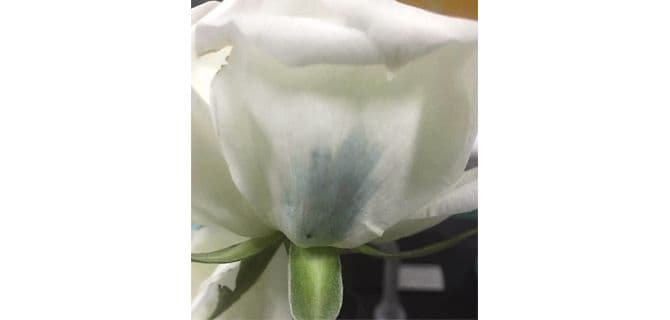For the FBI investigators of David Lynch’s Twin Peaks television series, “blue rose” cases involved the paranormal, the supernatural, and the downright weird. It’s an appropriate symbol: Blue roses do not grow naturally, and centuries of rose breeding have yet to create one that is unarguably blue. Now, scientists have created what they claim is […]

For the FBI investigators of David Lynch’s Twin Peaks television series, “blue rose” cases involved the paranormal, the supernatural, and the downright weird. It’s an appropriate symbol: Blue roses do not grow naturally, and centuries of rose breeding have yet to create one that is unarguably blue.
Now, scientists have created what they claim is the first biologically engineered blue rose. “Blue rose signifies unattainable hope,” says geneticist and biochemist Yan Zhang of Tianjin University, who helped to create the flower.
A flower’s color depends on a complex mix of factors, but pigments called anthocyanins typically play a key role. For example, pelargonidin gives a yellow hue, cyanidin provides red, and while delphinidin offers blue. These compounds are all made from the same precursor via enzymatic reactions and differ only in their number of hydroxyl groups. Crucially, roses do not possess the hydroxylase enzyme necessary to make blue delphinidin.
Back in 2007, the companies Suntory and Florigene unveiled a genetically engineered rose containing a biosynthetic pathway to produce delphinidin, which Suntory now sells as a blue rose called Applause. It’s pretty much the bluest rose around, but—without wanting to start a war of the roses—many people have pointed out that Applause is actually mauve.
This is probably because its color is modified by co-pigments or the acidic environment of the cell, either of which can redden delphinidin. “The environment of the plant cell makes it difficult to get the right anthocyanin shining through,” says Sarah E. O’Connor, a plant scientist at the John Innes Centre, who was not involved in the research.
So Zhang’s team looked to a different pigment, using synthetic biology techniques to help a rose produce indigoidine, a rich blue bacterial pigment with antioxidant and antimicrobial properties.
The researchers made a loop of DNA, known as a plasmid, which included two bacterial genes involved in indigoidine synthesis. Together, the two enzymes produced by these genes convert L-glutamine, an abundant amino acid in rose petals, into the blue pigment.
Zhang’s team added the plasmid to an agrobacterium that is widely used to transfer genes into plants. Then they injected the agrobacterium into the petal of a white rose, along with acetosyringone, a compound that induces gene transfer. After 12 hours, the petal sported a deep blue patch, which spectroscopy confirmed was caused by indigoidine.
O’Connor suggests that indigoidine is probably less susceptible than delphinidin to pH and co-pigment effects in the rose petals, which may explain its truer blue color. Zhang and colleagues “completely circumvented these environmental factors,” she says.
Although the experiment proves that the genetic equipment for making indigoidine can indeed turn a petal blue, the genes are not stably integrated into the plant’s genome, so it’s not possible to breed further blue roses from this flower. And the color’s appearance is frustratingly brief: The blue hue faded within a day as the agrobacteria carrying the genes caused the petal to wither. “This is not practical for the commercial generation of blue roses, but it’s a very practical way to do a proof of concept,” O’Connor says.
Advertisement
Zhang’s team now plans to use other genetic techniques to permanently modify the plant’s genome to make indigoidine, without injecting agrobacteria. “That will color the entire flower and make it inheritable,” he says. If it works, their blue variety could potentially tap into a $5 billion global market for roses, he notes.
